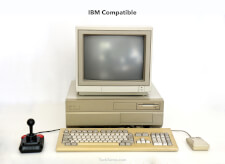IBM Compatible
The personal computer market in the early 1980's consisted primarily of Apple and IBM computers. Apple's systems ran a proprietary operating system developed by Apple, while IBM machines primarily ran PC-DOS. As the demand for personal computers began to grow, IBM decided to license the DOS operating system to other manufacturers. These companies began producing personal computers that were called PC clones or IBM compatibles.
As several other manufacturers began producing PCs, supplies grew and costs began to drop. This enabled more people to afford PCs and sales of IBM compatibles began to dominate the personal computer market. It wasn't long until the new manufacturers' PC sales surpassed the number of computers sold directly by IBM. The Apple Macintosh also gained substantial market share when it was introduced in 1984, but the low cost and wide availability of IBM compatibles kept their sales strong.
Sales of IBM compatibles surged again in 1995, when Microsoft introduced the Windows 95 operating system. However, by that time, the term "IBM compatible" had become almost irrelevant, since most PCs used Microsoft Windows as the primary operating system. Also, PC manufacturers had been building their own computers for many years, and there were few similarities between IBM's own PCs and IBM compatibles.
In 2005, IBM stopped manufacturing personal computers. The company that started the PC revolution is no longer in the market. Therefore, the term "IBM compatible" is a bit outdated, though it can still be used to describe Windows-based computers. The term "PC" is more appropriate, albeit a bit ambiguous, since Macs are technically PCs too. Therefore, the term "Windows computer" seems to be the best way to describe a modern day IBM compatible.
 Test Your Knowledge
Test Your Knowledge